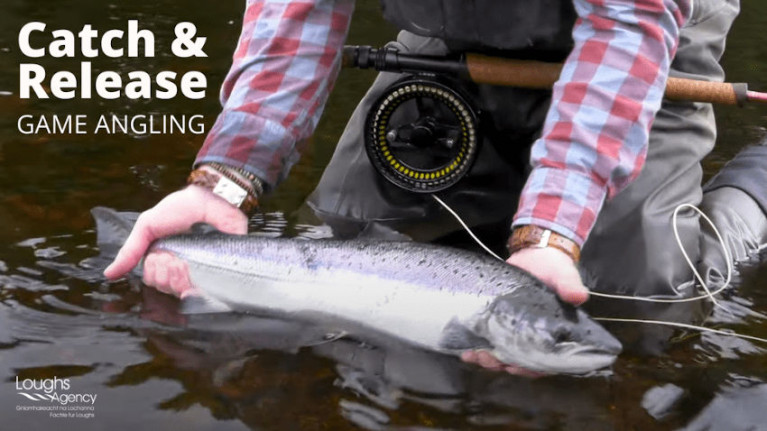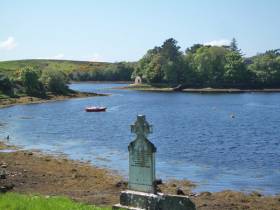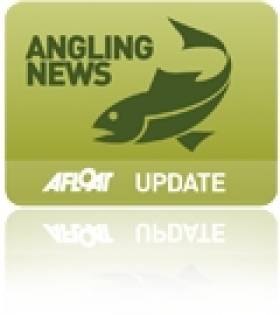Displaying items by tag: catch and release
Most Salmon Now ‘Released’ by Anglers in Ireland, New Report Says
A new report published by Inland Fisheries Ireland (IFI) shows that more wild salmon are now being ‘caught and released’ than ‘caught and kept’ by anglers in Ireland, to help conserve declining fish populations.
For the first time since records began in 2001, the Wild Salmon and Sea Trout Statistics Report 2020 shows that the number of salmon caught and released by anglers (51% of salmon caught) now outstrips the number of salmon that are kept (49% of salmon caught).
In all, 14,138 wild salmon and sea trout licences were issued to recreational anglers in 2020, while 78 public licences were made available to commercial fishermen.
IFI’s newly published report is based on the logbook returns of these licence holders, which shows that recreational anglers caught an estimated 78% of all salmon and sea trout last year, compared with commercial fishermen’s catch of 22%.
‘Catch-and-release angling by itself won’t solve the problem of declining fish populations, such as wild salmon or sea trout’
IFI chair Fintan Gorman praised the conservation efforts of anglers, clubs and federations around the country, saying: “Looking at statistics from the 2020 Wild Salmon and Sea Trout Report, it is encouraging to see anglers practicing ‘catch and release’ to a greater extent than ever before. Anglers released 51% of their wild salmon catches in 2020, compared with 47% in 2019 and that’s a very positive development.
“However, catch-and-release angling by itself won’t solve the problem of declining fish populations, such as wild salmon or sea trout. That’s why Inland Fisheries Ireland will continue implementing other important measures too, such as fish barrier mitigation, water quality monitoring, ‘invasive species’ control and enforcement patrols of fisheries.
“We will also keep promoting the sustainable stewardship of our precious salmon fishery through our schools and marketing programmes. These are all crucial factors in protecting and conserving our fish populations and their habitats for the benefit of this generation and future generations to come.”
The Wild Salmon and Sea Trout Tagging Scheme provides the state agency with data to assist with the protection, management and conservation of wild salmon and sea trout.
IFI chief executive Francis O’ Donnell has also welcomed the positive conservation efforts being made by citizens across the country to protect Ireland’s salmon and sea trout resource.
“Atlantic salmon and sea trout are facing a very uncertain future due to habitat degradation, water quality issues, unacceptable levels of poaching, marine migration issues and the effects of climate change,” he said.
“As always, our staff are deeply committed to executing our statutory role to enforce, protect and conserve our native fish stocks and in particular salmon and migratory sea trout. This is very much aligned with our new corporate plan and vision as the statutory agency charged with protecting the inland fisheries Resource.”
According to IFI’s 2020 report, five rivers accounted for over half of all salmon caught by anglers and commercial fishermen last year: the River Moy in Co Mayo, the River Blackwater in Lismore, Co Waterford, the River Laune in Co Kerry, the Corrib in Co Galway and the Lower Lee in Cork.
A total of 27,829 wild salmon were caught collectively by commercial fishermen and recreational anglers in 2020, including salmon which were later released. For sea trout, the total catch recorded last year was 1,394 when figures for commercial fishermen and anglers are combined.
‘Atlantic salmon and sea trout are facing a very uncertain future’
Meanwhile, between now and 1 December, IFI is running a public consultation on the future management of the Wild Salmon and Sea Trout Tagging Scheme, as previously reported on Afloat.ie.
The State agency is encouraging anyone with an interest in the area to submit their views on how the tagging system can be improved and modernised. It is especially keen to hear from salmon and sea trout anglers, angling clubs, commercial fishermen and those businesses that distribute salmon and sea trout licences, such as fishing tackle shops.
Loughs Agency Renews Appeal for Anglers to ‘Catch & Release’
The Loughs Agency has launched a new campaign appealing for angling enthusiasts to embrace the practice of catch and release to help sustain fish stocks in the Foyle and Carlingford areas.
The agency says it welcomes the growing trend of catch and release angling as a way of continuing to fish while limiting the impact on local stocks.
And it has produced a video guide to help anglers with their catch and release technique in order to increase the survival rate of salmon after release.
John McCartney, the agency’s director of conservation and protection, also explains the carcass tagging scheme which applies to salmon, brown trout and sea trout retained by recreational anglers, and highlighted the importance of returning any unused tags.
The Loughs Agency is aiming for a catch and release rate of over 80% for salmon and sea trout caught during the new season which is now partially underway.
It also wants to further reduce the number of anglers opting to take tags when purchasing a licence.
‘The agency welcomes this approach to angling and would encourage all anglers to practice this method’
McCartney says: “Last year, 45% of anglers purchasing a licence opted not to take tags and there is a growing trend of anglers implementing the practice of catch and release.
“The agency welcomes this approach to angling and would encourage all anglers to practice this method as a way of continuing to fish, whilst limiting the impact on local stocks.
“Numbered tags are allocated to anglers who request them when they purchase their licence. The angler then records their retained catch and the corresponding carcass tag number when updating their catch return during the fishing season, returning any unused tags to Loughs Agency when their licence expires.
“The catch return data from anglers is analysed throughout the season and used to make fishery management decisions to ensure the sustainability of species in Foyle and Carlingford.”
For the 2021 season, the Loughs Agency is issuing a maximum of one blue tag for the period from 1 March to 31 May and/or a maximum of two black tags for the period from 1 June to 31 October, depending on the type of licence purchased. Tackle shops have been instructed not to issue more than these maximum quantities for the 2021 season.
The above video guide to good practice for anglers with their catch and release technique includes the following pointers:
- Landing the fish quickly to avoid exhausting the fish.
- Use a soft knotless mesh net and keep the fish in the water at all times.
- If you must handle the fish, use wet hands and cradle it below the belly. Never put your fingers inside the gill covers or lift the fish by the tail.
- Use a single barbless hook to limit injury during removal. Remove the hook immediately, keeping the fish in the water.
- If the hook is caught deep in the fish, cut the line and release with hook still inside rather than trying to remove deep-caught hook.
- When releasing the fish, support it in the water using two hands, with the head pointing upstream to aid breathing.
The season has already started on some still-water fisheries, with fishing on the rivers beginning to open up from Monday 1 March.
For further information on season dates, licence and permit requirements in the Foyle and Carlingford areas, visit the angling section of the Loughs Agency website.
#Angling - Only hours after 84 Irish rivers were opened to salmon angling on Tuesday 1 January, the first salmon of 2019 was caught and released on the Lackagh River in Co Donegal.
Michael McCann of Templeard, Derry landed the 5lb fish in the Garden Pool on the Lackagh River at 9.25am yesterday using a single barbless hook, before it was released back into the water.
The fish was also the first salmon caught and released during International Year of the Salmon which takes place throughout 2019.
McCann was one of 22 anglers who were fishing on the Lackagh at the time of the catch. The river is not known for producing the first salmon of the angling season — in 2018, the first was recorded on the River Drowes in Leitrim on 30 January while in 2017 it was caught on the Munster Blackwater in Cork on 1 February.
Congratulating McCann on his catch, Dr Ciaran Byrne, CEO of Inland Fisheries Ireland, said: “We are particularly delighted that the first salmon of 2019 was caught and released in a sustainable manner in Donegal in compliance with the 2019 regulations.
“I would urge anglers to step up their conservation efforts and engage in catch and release angling in 2019. The new year coincides with International Year of the Salmon which aims to raise awareness of some of the challenges facing salmon stocks across the Northern hemisphere.
“Salmon populations have plummeted in recent years with the number of salmon returning to Irish shores decreasing by over 70%, which is very concerning.
“We look forward to promoting this global initiative in Ireland which aims to bring people together to share knowledge, raise awareness and take action on how we can ensure the resilience of salmon in Ireland and across the Northern hemisphere.”
The Lackagh River is open to catch and release fishing during the 2019 season. The regulations for the management of the wild salmon and sea trout fishery for 2019 including the list of open, catch and release and closed rivers can be found on the IFI website.
‘CPR’ Saves Fish As New Conservation Campaign Launches
#Angling - CPR saves fish, according to Inland Fisheries Ireland (IFI) at the launch of a new campaign to highlight angling and the importance of conservation.
The hashtag #CPRsavesfish has been placed across a number of bridges and high footfall locations across the country to engage the public around the pursuit of conservation-focused angling.
‘CPR’ stands for ‘catch-photo-release’ and refers to a method of angling where a fish is caught and subsequently returned unharmed back into the water.
This angling technique is proven to contribute to the maintenance of healthy fish stocks and ensures future generations can continue to enjoy the recreational and economic benefits of the fisheries resource.
IFI is supporting catch and release across all types of angling including pike, coarse, salmon and trout fishing as well as sea angling. The method results in positive survival rates for fish when caught using best practise methods.
Research carried out by IFI and the Norwegian Institute for Nature Research in 2014 examined the survival of salmon after catch and release fishing in three Irish rivers: the Owenmore in Co Mayo, the Mulkear in Co Limerick and the Feale in Co Kerry. Overall, 92% of the Atlantic salmon recorded after tagging survived after catch and release.
The #CPRsavesfish stencils can be found in urban locations in each River Basin District in Ireland including Dublin, Cork, Galway, Limerick, Letterkenny and Kilkenny.
The hashtag stencils, which have been power washed with water onto pavements, are completely environmentally friendly and are expected to fade naturally in the coming weeks.
Suzanne Campion, head of business development at IFI, said: “This awareness campaign aims to put angling on the general public’s radar by playing on the concept of CPR as a lifesaving mechanism and to engage existing anglers around the practise of catch and release fishing.
“Catch-photo-release angling ensures the sustainability of our fisheries resource in the long term with most sporting anglers in Ireland already practicing catch and release to some degree, recognising that it ensures the maintenance of healthy fish stocks and the sustainability of the sport in the long term.
“Angling is a pursuit that can be enjoyed at any age or ability and Ireland has a host of top angling destinations right on doorsteps across the country. We are encouraging novice anglers to visit the #CPRsavesfish website to find out more about how they can try fishing in their local area.”
There are currently 273,600 domestic anglers in Ireland with a further 163,000 international visitors who enjoy fishing here. Angling supports 11,000 jobs nationwide, often in rural and peripheral communities, and contributes €836 million to the Irish economy every year.
#Angling - An angling bye-law focusing on salmon and sea trout has come into effect for Burrishoole, Co Mayo.
Sean Kyne, Minister of State with responsibility for Inland Fisheries, introduced the Conservation of Salmon and Sea Trout Shramore (Burrishoole)(Catch and Release) Bye Law No 951 into operation on Tuesday 13 June.
The new bye-law provides for catch and release angling for salmon and sea trout over 40cm in length in the Shramore (Burrishoole) system, and applies to Lough Furnace and the Seven Arch Bridge on the L5435 (old Newport Road).
Operative from Wednesday 14 June till Saturday 30 September, the bye-law and provides for the use of single barbless hooks while prohibiting the use of worms as bait in angling for salmon and sea trout.
‘Catch and release’ angling refers to the method of carefully handling any fish caught and immediately returning the fish alive to the water. This form of angling has a significant positive impact on the survival rate of released fish.
In addition, salmon and sea trout caught by fly fishing using single barbless hooks have a greater chance of survival than fish caught on barbed hooks. Barbless hooks do less damage, are easier to remove and reduce handling time which can be an important factor influencing survival.
Salmon and sea trout are some of Ireland’s main wild fish species attracting domestic and overseas anglers alike. Angling contributes €836 million to the Irish economy annually and supports upwards of 11,000 jobs which are often in rural communities.
Dr Ciaran Byrne, chief executive of Inland Fisheries Ireland, said: “Our salmon and sea trout stocks are extremely valuable. These new measures at Shramore, Burrishoole, will allow us to introduce a number of important methods which will help us protect these populations into the future.”
Anglers are requested to familiarise themselves the details of the new bye-law, available as a PDF to read or download HERE.
South Coast Hosts First Irish Bass Festival
#ANGLING - Ireland's south coast will play host to the first Irish Bass Festival this July.
Created and organised by Absolute Fishing, the lure angling event is open to all shore anglers at various venues between Tramore and Dungarvan in Co Waterford, which provide some of the best bass fishing in Europe.
The Irish Bass Festival will operate on catch-and-release rules, with anglers having to photograph their fish, using their own measuring board combined with a unique ID card provided by the organisers.
Competing anglers are also free to roam and fish anywhere along the coastline from Wexford to Cork - provided they're back in time to register their fish!
Details on requirements, reception and fishing times are available on the Irish Bass Festival website HERE.
Shore Angling Competition Raises Funds for Courtown Lifeboat
#ANGLING - Strongs winds and heavy seas weren't enough to dampen the spirits of the anglers taking part in the Courtown Sea Anglers RNLI fundraising event last Sunday, the Gorey Guardian reports.
Top winner on the day in the shore angling competition at Kilgorman beach was James Ryan from New Ross, who hooked an impressive 24 fish - all of which went back in the water under catch-and-release rules.
Anglers from Galway, Belfast, Clare, Wicklow, Dublin, Waterford and across Wexford took part. It is hoped that more than €4,200 was raised to support the Courtown lifeboat.
Special Angling Event Produces First Salmon of 2012
#ANGLING - The first wild Atlantic spring salmon of 2012 was caught Sunday on the River Liffey in exceptional circumstances, The Irish Times reports.
Though the river is closed for salmon fishing as stocks are currently below sustainable levels, Inland Fisheries Ireland sanctioned a special catch-and-release club event for survey reasons at Islandbridge in the capital.
Declan Briggs – a 47-year veteran of the Dublin and District Salmon Anglers' Association - landed the 8.5lb beauty using a wooden Devon lure at 9.50am.
“This is my first time to catch the first fish. I’m absolutely delighted," he said.
Elsewhere in Ireland, Briggs' catch was mirrored by Tyrone man Ian Martin, who caught the northern region's first salmon on the year on the River Drownes near Bundoran.
The Irish Times has more on the story HERE.
Angling Event Raises Funds for Howth Lifeboat
A boat angling event in Dublin last week raised €1,000 for the RNLI Howth Lifeboat, The Irish Times reports.
The third annual Paul Lynam Memorial Cup catch-and-release contest, hosted by the Howth Angling Centre, saw 35 anglers from north Dublin compete in perfect calm conditions, with ray, pollack and dogfish among the haul.
Overall winner on the day was Anthony McLaughlin from Rush, who scored 170 points to lift the cup and prize money of €300 in his first big competition victory.
But the bigger winner from the event was Howth lifeboat, which was among the top five busiest in 2010.
Howth RNLI chairman Russell Rafter said: “Our collection boxes from the [Howth Angling Centre] are the highest contributor to the station.”




































































